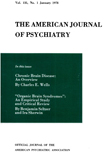A SOCIOPSYCHIATRIC STUDY OF TWENTY-FIVE YOUNG OFFENDERS
Abstract
A review of the case material points up 4 significant findings:
1. The short period of residence in New York City of a large number of offenders, i.e., less than 6 months at the time of arrest. As is to be expected, the greatest metropolis in the world attracts the unstable, unrooted, impulsive adolescent who seeks his fortune and anonymity because life in his home town offers little adventure. They seem to take jobs of short duration, with little compensation in terms of monetary reward or satisfaction, and thus, frustrated and disappointed again, are apt to choose an easy way of survival.
2. The loss of parents by death, desertion, and broken homes was found in the life history of almost half of the offenders. In this respect this group is similar to younger and adolescent offenders, as reported by others studying delinquency. It is fair to assume, therefore, that separation from parents at the early age cited, before the tenth year, is a serious predisposing factor toward antisocial and delinquent behavior.
3. The inability of these boys to sustain efforts in terms of educational and vocational achievement is striking. Despite their "affect-hunger" they did not sublimate by learning a skill, or trade, or schooling for some of their unfilled needs. The lack of libidinal development and subsequent weak ego growth seems to result in a total inability to achieve satisfaction in a socially acceptable sense, in terms of schooling and work.
4. The high incidence of neurotic traits indicates that for the most part behavior in this group fell between two poles—antisocial character and neurotic acting out. The majority of the subjects showed a combination of both.
In addition, our psychiatric findings would place these offenders in three major groups, as follows:
(A.) The antisocial character,
(B.) The antisocial character associated with neurotic conflicts,
(C.) Primarily neurotic personalities with minimal antisocial character formation.
Access content
To read the fulltext, please use one of the options below to sign in or purchase access.- Personal login
- Institutional Login
- Sign in via OpenAthens
- Register for access
-
Please login/register if you wish to pair your device and check access availability.
Not a subscriber?
PsychiatryOnline subscription options offer access to the DSM-5 library, books, journals, CME, and patient resources. This all-in-one virtual library provides psychiatrists and mental health professionals with key resources for diagnosis, treatment, research, and professional development.
Need more help? PsychiatryOnline Customer Service may be reached by emailing [email protected] or by calling 800-368-5777 (in the U.S.) or 703-907-7322 (outside the U.S.).



